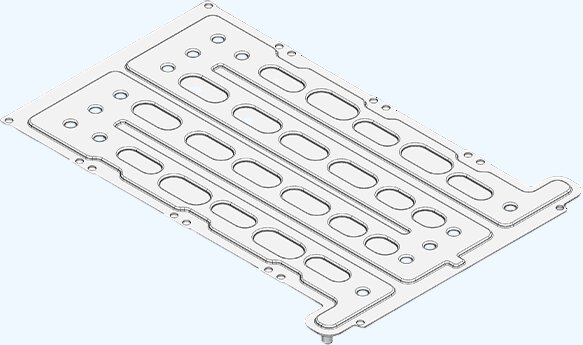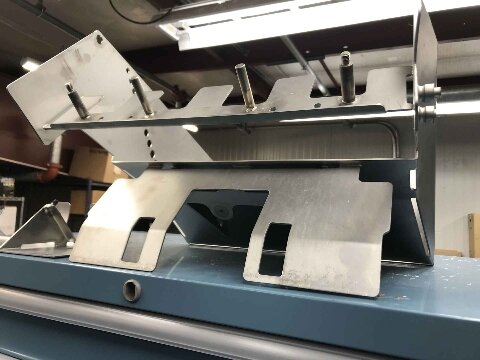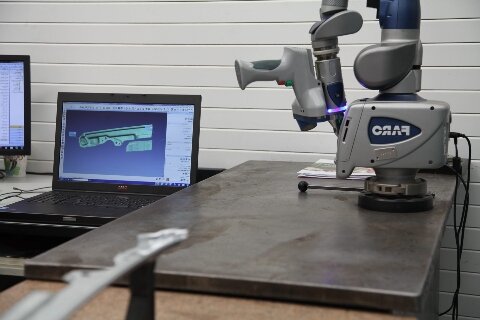تواجه العديد من الشركات المصنعة تحدي قطع الصفائح المعدنية بدقة وكفاءة. يمكن أن تكون الأجزاء غير منتهية بشكل جيد بدون التقنيات الصحيحة، مما يؤدي إلى مزيد من الوقت والعمالة والتكلفة. يحل قص الصفائح المعدنية هذه المشكلة من خلال توفير طريقة قطع دقيقة وفعالة من حيث التكلفة لأنواع مختلفة من الصفائح المعدنية.
هل تريد أن تعرف كيف تؤثر محاذاة الشفرة أو سُمك المادة على نتائجك؟ دعنا نتعرف على الآليات والفوائد وأفضل الممارسات.
ما هو قص الصفائح المعدنية؟
يتضمن قص الصفائح المعدنية تقطيع الصفائح المعدنية المسطحة إلى قطع أصغر باستخدام شفرتين. تقوم الشفرة العلوية بتطبيق القوة على المادة، وتضغطها على الشفرة السفلية لإنشاء قطع نظيف ومستقيم. لا تنطوي هذه العملية على حرارة، مما يجعلها مثالية للحفاظ على سلامة المواد.
كيف يعمل القصّ?
هل لديك فضول حول الآليات الكامنة وراء هذه العملية؟ دعنا نفصلها خطوة بخطوة.
- إعداد الشفرة: يتم وضع الشفرة العلوية بزاوية طفيفة (2-3 درجات) لتقليل القوة المطلوبة للقطع.
- تشبيك المواد: يتم إمساك الصفيحة المعدنية بإحكام لمنع تحركها أثناء القطع.
- إجراء القطع: تنزل الشفرة العلوية إلى الأسفل، وتضغط لكسر المعدن على طول الخط المقصود.
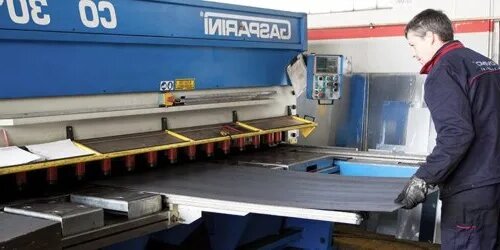
تقنيات القص الأساسية
تقنيات القص هي المفتاح في تصنيع الصفائح المعدنية. دعنا نستكشف الطرق الأكثر شيوعًا لإجراء عمليات قص دقيقة وفعالة.
القص المقصلة
القص بالمقصلة هو أحد أكثر الطرق شيوعًا لقطع الصفائح المعدنية. وهي تستخدم شفرة مستقيمة تتحرك عمودياً لقطع المادة. تُعد هذه التقنية مثالية لإنشاء قطع طويلة ومستقيمة بدقة عالية.
القص الدوار
يستخدم القص الدوّار شفرتين دائريتين دوّارتين لقطع الصفيحة المعدنية. هذه الطريقة مثالية للقطع المنحني أو الدائري، مما يجعلها متعددة الاستخدامات للأشكال المخصصة. وغالباً ما تُستخدم في تطبيقات مثل إنشاء حلقات معدنية أو تشذيب الحواف على المكونات المنحنية.
التثقيب والقص بالمثقاب والقالب
لكمة ويستخدم القص بالقالب مثقابًا لإجبار المعدن على الدخول في القالب، مما يؤدي إلى إحداث قطع. هذه التقنية دقيقة للغاية ومناسبة للتخفيضات المتكررة للإنتاج بكميات كبيرة.
القضم
القضم هي عملية يقوم فيها مثقاب صغير بإزالة قطع صغيرة من المعدن في قطع متداخلة. تُعد هذه الطريقة ممتازة لإنشاء أشكال معقدة أو حواف غير منتظمة بدون أدوات مخصصة.
مواد قص الصفائح المعدنية
يعمل قص الصفائح المعدنية مع مختلف المواد، مما يوفر خصائص فريدة لتطبيقات مختلفة. فيما يلي تفصيل للمعادن الأكثر استخدامًا في عمليات القص:
- فُولاَذ
- الفولاذ المقاوم للصدأ
- الألومنيوم
- نحاس
- نحاس
- التيتانيوم
الاعتبارات الرئيسية عند قص المواد:
- سماكة: تتطلب المواد السميكة قوة أكبر وشفرات أكثر حدة.
- صلابة: تتطلب المعادن الأكثر صلابة مثل الفولاذ المقاوم للصدأ أو التيتانيوم شفرات متينة وإعدادات دقيقة.
- صقل الأسطح: بعض المواد، مثل الألومنيوم أو النحاس الأصفر، عرضة للخدوش، لذا فإن التعامل السليم معها ضروري.
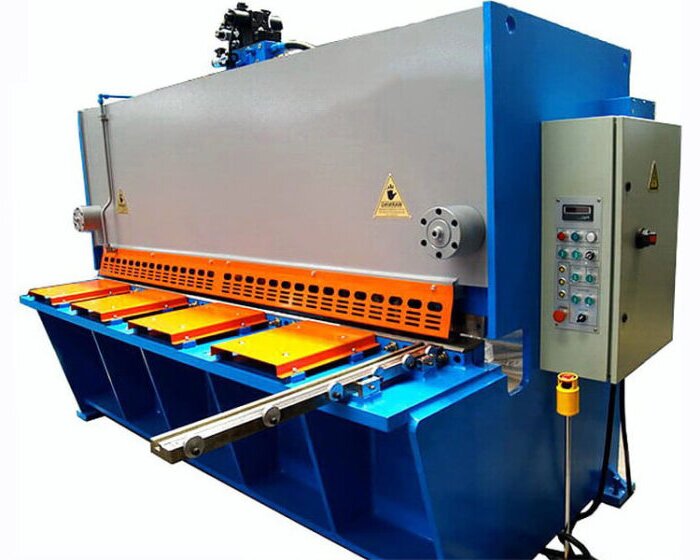
قص الصفائح المعدنية: الفوائد والقيود
يوفر قص الصفائح المعدنية العديد من المزايا، ولكن له أيضًا قيود. يمكن أن يساعدك فهم كلاهما في اختيار الطريقة المناسبة لمشروعك.
فوائد قص الصفائح المعدنية
- دقة: يوفر القص قطعًا نظيفًا ومستقيمًا بأقل قدر من التشويه، مما يجعله مثاليًا للمشاريع عالية الدقة.
- سرعة: العملية سريعة، خاصةً لتقطيع الصفائح المعدنية الكبيرة إلى قطع أصغر وموحدة.
- فعاله من حيث التكلفه: يتطلب القص طاقة أقل من طرق القطع الأخرى، مما يقلل من التكاليف التشغيلية.
- الحد الأدنى من هدر المواد: ينتج عن القص الحد الأدنى من الخردة مقارنة بطرق القطع الأخرى، مما يساعد على توفير تكاليف المواد.
حدود قص الصفائح المعدنية
- حدود السُمك: القص ليس مثاليًا للصفائح المعدنية السميكة جدًا. فكلما كانت المادة أكثر سمكًا، زادت القوة المطلوبة، مما يحد من نطاق الاستخدام.
- تشكيل بور: يمكن أن ينتج عن القص نتوءات على طول حواف المعدن المقطوع، مما قد يتطلب تشطيبًا إضافيًا أو عمليات إزالة الأزيز.
- يقتصر على القطع المستقيم: بينما يتفوق القص في القص المستقيم، إلا أنه غير مناسب للمنحنيات المعقدة أو الأشكال التفصيلية.
- تشويه الحواف: في بعض الحالات، يمكن أن تصبح حواف المعدن المقطوع مشوهة قليلاً، مما يتطلب المزيد من التعديلات أو المعالجة.
أفضل الممارسات لتحقيق نتائج قص مثالية
يتطلب تحقيق أفضل النتائج في قص الصفائح المعدنية الاهتمام بالتفاصيل والتقنيات المناسبة. يضمن اتباع أفضل الممارسات هذه الدقة والكفاءة والنتائج طويلة الأمد.
اختيار المقص المناسب للمهمة
عند اختيار آلة القص، من المهم مراعاة نوع المادة وسُمكها. تتطلب المواد الأكثر سمكًا ماكينات أكثر قوة، بينما يمكن قص المعادن الأكثر ليونة مثل الألومنيوم بقوة أقل.
نظرًا لسرعتها واتساقها، غالبًا ما يُفضل استخدام المقصات الهيدروليكية أو المقصلة للإنتاج بكميات كبيرة. قد يكون المقص الميكانيكي أكثر ملاءمة للقطع الأصغر والأكثر تعقيدًا.
منع النتوءات وتشوه الحواف
غالبًا ما تحدث النتوءات وتشوه الحواف بسبب إعدادات القص غير الصحيحة أو الشفرات الباهتة أو سرعة القطع المفرطة. كما يمكن أن تؤدي الشفرات ذات المحاذاة الرديئة أو نوع القص الخاطئ بالنسبة لسُمك المادة إلى ضعف جودة القطع.
لتجنب النتوءات، تأكد من أن شفرات القص حادة ومحاذاة بشكل صحيح. يمكن أن يؤدي تقليل سرعة القطع قليلاً إلى تقليل تشوه الحافة وتحسين جودة القطع.
الصيانة وشحذ الشفرات
جقم بتنظيف الشفرات بشكل متكرر لإزالة الحطام ومنع التراكم. يمكن أن يؤدي تشحيم آلية القص أيضًا إلى تقليل الاحتكاك وإطالة عمر الشفرات.
إذا لاحظت وجود نتوءات مفرطة أو تشوه في الحواف أو عمليات قطع غير متناسقة، فقد يكون الوقت قد حان لاستبدال الشفرات. يمكن أن تتسبب الشفرات الباهتة في زيادة إجهاد المواد والقطع غير المتساوي، مما يؤدي إلى جودة منتج رديئة.
التطبيقات الصناعية لقص الصفائح المعدنية
يلعب قص الصفائح المعدنية دورًا مهمًا في مختلف الصناعات، مما يتيح إنتاج مكونات دقيقة وعالية الجودة. دعونا نستكشف كيفية تطبيق هذه العملية في مختلف القطاعات الرئيسية.
تصنيع السيارات
يُستخدم القصّ في صناعة السيارات لإنشاء ألواح هياكل السيارات, اقواسومكونات الهيكل. تضمن هذه العملية إجراء عمليات قطع نظيفة ومستقيمة للأجزاء التي تتطلب تفاوتات ضيقة ومتانة.
الإنشاءات والتصنيع الإنشائي
يُستخدم القص في البناء لقطع العوارض الفولاذية وألواح الأسقف ومكونات الإطارات. كما تُنشئ هذه الطريقة أيضاً أنابيب أنابيب التدفئة والتهوية وتكييف الهواء، والسلالم، والتركيبات المعدنية المخصصة للمباني.
تطبيقات الفضاء والتطبيقات عالية الدقة
يعمل القص على تصنيع مكونات خفيفة الوزن لكنها قوية مثل جلود الطائرات والأقواس وأجزاء المحرك في مجال الطيران. كما يُستخدم القص عالي الدقة لإنتاج مكونات الأقمار الصناعية والآلات المتخصصة.
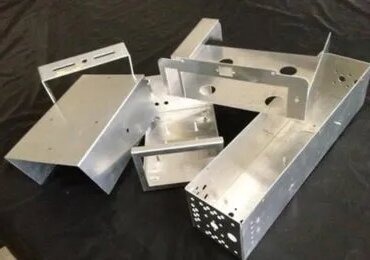
ما الفرق بين القص والقطع؟
في حين أن القص والقطع هما طريقتان تستخدمان لفصل المواد إلى الأشكال أو الأحجام المرغوبة، إلا أن هناك اختلافات واضحة في العمليات وتطبيقاتها.
- الطريقة: يستخدم القص شفرتين لتطبيق قوة القص، بينما يمكن أن يتضمن القطع تقنيات مختلفة مثل النشر أو استخدام الحرارة.
- التطبيقات: يعد القص مثاليًا للقطع المستقيم في المواد الرقيقة بينما يمكن لطرق القطع مثل الليزر والبلازما التعامل مع الأشكال المعقدة والمواد الأكثر سمكًا.
- دقة: يوفر القص عادةً قطعًا مستقيمًا ونظيفًا، في حين أن طرق القطع الأخرى قد تنتج جودة حواف متفاوتة اعتمادًا على المواد والتقنية المستخدمة.
ما الفرق بين القص والطمس؟
القص و تقطيع هي عمليات قطع تخدم أغراضًا مختلفة وتؤدي إلى نتائج مختلفة.
- غاية: يُستخدم القص لتقطيع الصفائح إلى أقسام أصغر، بينما يُستخدم الطمس لقطع أشكال محددة من الصفائح الأكبر حجمًا.
- النتيجة النهائية: ينتج القص مقاطع مشذّبة، بينما ينتج الطمس جزءًا نهائيًا (الفراغ).
- جودة الحافة: يتطلب التقطيع حواف أنظف وأكثر دقة لأن الفراغ هو الجزء النهائي. قد يترك القص حواف أكثر خشونة تحتاج إلى تشطيب.
خاتمة
يُعد قص الصفائح المعدنية عملية متعددة الاستخدامات وفعالة لتقطيع المعادن إلى أشكال أو أحجام محددة. وهي توفر العديد من المزايا، مثل الدقة والسرعة والفعالية من حيث التكلفة، مما يجعلها مثالية لصناعات السيارات والبناء والفضاء. على الرغم من أن القص مثالي للقطع المستقيم والإنتاج بكميات كبيرة، فإن فهم حدوده وأفضل الممارسات يضمن الحصول على أفضل النتائج.
إذا كانت لديك أي أسئلة أو كنت بحاجة إلى مساعدة الخبراء في مشروعات الصفائح المعدنية، فلا تتردد في الاتصال ب اتصل بنا!
مهلا، أنا كيفن لي

على مدى السنوات العشر الماضية، كنت منغمسًا في أشكال مختلفة من تصنيع الصفائح المعدنية، وشاركت رؤى رائعة هنا من تجاربي عبر ورش العمل المتنوعة.
ابقى على تواصل

كيفن لي
لدي أكثر من عشر سنوات من الخبرة المهنية في تصنيع الصفائح المعدنية، وتخصصت في القطع بالليزر، والثني، واللحام، وتقنيات معالجة الأسطح. كمدير فني في شنغن، أنا ملتزم بحل تحديات التصنيع المعقدة ودفع الابتكار والجودة في كل مشروع.

